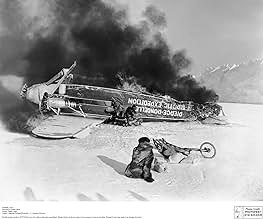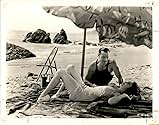VALUTAZIONE IMDb
6,3/10
808
LA TUA VALUTAZIONE
Aggiungi una trama nella tua linguaJack Bradon is tasked to reach the South Pole with a dirigible.Jack Bradon is tasked to reach the South Pole with a dirigible.Jack Bradon is tasked to reach the South Pole with a dirigible.
- Regia
- Sceneggiatura
- Star
- Premi
- 2 vittorie totali
Emmett Corrigan
- Rear Adm. John S. Martin
- (as Emmet Corrigan)
Richard Alexander
- Radio Operator
- (non citato nei titoli originali)
Bess Flowers
- Party Guest
- (non citato nei titoli originali)
George 'Gabby' Hayes
- Parade Official
- (non citato nei titoli originali)
Edward Hearn
- Admiral's Aide
- (non citato nei titoli originali)
Selmer Jackson
- Lt. Rowland
- (non citato nei titoli originali)
Eddie Kane
- Lakehurst Radio Announcer
- (non citato nei titoli originali)
Kenneth MacDonald
- Lt. Fogarty
- (non citato nei titoli originali)
Adrian Morris
- Dirigible 'Los Angeles' Crewman
- (non citato nei titoli originali)
William H. O'Brien
- Sailor
- (non citato nei titoli originali)
Broderick O'Farrell
- Doctor
- (non citato nei titoli originali)
Recensioni in evidenza
I liked this film for it conveys a can-do-attitude that was so prevalent in America at that time. This movie was made (1931) in a time when man was just beginning to test the limits of himself, machine, and the elements (it was only 5 years earlier in 1927 that Limbergh crossed the Atlantic in the Spirit of St. Louis.) This movie focused on the race to the south pole and it made for good entertainment. The special effects for the time were very good.
The human interest aspect of the film showed the negative side of ambition (how it affected a marriage and a friendship)this I found interesting. The character development in the one, Frisky, was especially satisfying.
I would recommend this movie to anyone--however do not compare it to the movies of our time--that would be a disservice to the movie.
The human interest aspect of the film showed the negative side of ambition (how it affected a marriage and a friendship)this I found interesting. The character development in the one, Frisky, was especially satisfying.
I would recommend this movie to anyone--however do not compare it to the movies of our time--that would be a disservice to the movie.
Return to the heady days of the 1920s, when the strategic bombers of World War I were still seen as a viable alternative to the rickety airplanes of the day. While the acting is wooden and stereotypical (brave fly boy, conservative large "ship" commander, frail stay at home wife), just seeing the footage of the long-gone rigid airships is worth the tariff.
The best shot is near the beginning, when the camera pans upward, past round naval observation balloons, surprisingly modern non-rigid 'blimps' flying in formation, and then (above them all) the massive (larger by a factor of five or more) dirigible of the title.
Scenes of the real dirigible flying, landing, dropping naval "parachute men", and hooking up to the mooring mast are also worth the time.
Not so much the rest of the movie. Period special effects do not hold up well under modern scrutiny, and the silly pining away of Fay Wray really gets in the way.
(Odd too is the fact that the Review Board passed on a plot line involving an obviously cheating on her husband woman, including a racy scene at the beach where the two have been sharing an afternoon swimming, barely clad by 1930s standards). Perhaps this was during the Hays to Breen transition period, and it slipped under the radar.)
Note that the poor USS Pensacola (a mythical Navy airship; there was a cruiser by that name but never an aircraft) doesn't catch fire, despite the dramatic breakup of the structure. US airship were filled with helium (due to the almost monopolistic corner of the world's supply of helium by the US), and although they suffered through a series of dramatic crashes (Shenandoah, Akron, Macon), none of them caught fire a la the Hindenburg.
Buy it in the newly released DVD for the flying, and try to ignore the rest. (Oh, and Fay Wray looks far better as a brunette than she ever did as a blonde.)
The best shot is near the beginning, when the camera pans upward, past round naval observation balloons, surprisingly modern non-rigid 'blimps' flying in formation, and then (above them all) the massive (larger by a factor of five or more) dirigible of the title.
Scenes of the real dirigible flying, landing, dropping naval "parachute men", and hooking up to the mooring mast are also worth the time.
Not so much the rest of the movie. Period special effects do not hold up well under modern scrutiny, and the silly pining away of Fay Wray really gets in the way.
(Odd too is the fact that the Review Board passed on a plot line involving an obviously cheating on her husband woman, including a racy scene at the beach where the two have been sharing an afternoon swimming, barely clad by 1930s standards). Perhaps this was during the Hays to Breen transition period, and it slipped under the radar.)
Note that the poor USS Pensacola (a mythical Navy airship; there was a cruiser by that name but never an aircraft) doesn't catch fire, despite the dramatic breakup of the structure. US airship were filled with helium (due to the almost monopolistic corner of the world's supply of helium by the US), and although they suffered through a series of dramatic crashes (Shenandoah, Akron, Macon), none of them caught fire a la the Hindenburg.
Buy it in the newly released DVD for the flying, and try to ignore the rest. (Oh, and Fay Wray looks far better as a brunette than she ever did as a blonde.)
As we watch the Twentieth Century disappear in our wake, we're going to find films like this more and more precious. I mean, can you imagine? -- Here's a film that takes the airship absolutely seriously as an equal partner with the airplane. Here's a film that shows you basically how an airship was constructed and what it looked like inside, and all that as part of the plot! And if you're going to interrupt the main plot with a soap opera, who better to put in front of your eyes than the beautiful Fay Wray? And what a great way to get out of the romantic sub-plot's basic dilemma -- nice, clean, and fast. All things considered, a more than satisfying way to spend an evening.
A reasonably decent motion picture for its time, the one attribute that makes this film stand out from its standard storyline, is its footage and scenes regarding dirigibles. When this film was released in 1931, it was the golden age of zeppelin travel, and the crash of the Hindenburg, which doomed this type of transportation, was still five years in the future. There were numerous scenes shot at Lakehurst Naval Air station, where ironically the Hindenburg crashed, that was the center of dirigible activity at the time for the U.S. Navy. As someone who is interested in this subject, I found this part of the movie fascinating as well as the part of the story that took you behind the scenes of airship travel and how much danger could be involved. The riveting scene dealing with the crash of a dirigible in a violent storm brought to mind the U.S. Navy zeppelin Akron, launched the same year as this film, which was destroyed in a similar storm only two years later. It was also interesting to see actress Fay Wray two years before she would gain fame with her role in King Kong. I had the opportunity to catch this film recently during an airing on the TCM cable channel and would recommend it for anyone with a similar interest.
The "7" is strictly for the amazing aerial scenes involving airships or dirigibles (like the Hindenberg that crashed at Lakehurst, N.J.). In fact, all of the aviation moments are skillfully photographed for dramatic effect, especially the fierce electrical storm that destroys one of the dirigibles by pulling it apart in mid-flight.
The romance on the ground is far less convincing than the action sequences involving pilots flying to the South Pole. FAY WRAY is the femme lead, hopelessly in love with hubby RALPH GRAVES and begging his best friend JACK HOLT not to use him on his expedition to the South Pole. She's sick of staying behind and worrying about him and his grandstanding exploits. Unfortunately, none of the domestic scenes between Graves and Wray bear any semblance to reality--her weeping gets pretty tiresome before the plot is resolved.
But FAY WRAY was unquestionably a beautiful woman and director Frank Capra gives her plenty of close-ups. Her role is not particularly well written and she has trouble being anything more than a decorative ploy. RALPH GRAVES is not totally convincing as a reckless pilot. There's an awkwardness about his acting that is somewhat disconcerting here. JACK HOLT handles his role with authority and good screen presence.
A fascinating look at early aviation exploits using dirigibles and balloons when they were seriously considered to be the modern methods of aviation. Well worth watching.
The romance on the ground is far less convincing than the action sequences involving pilots flying to the South Pole. FAY WRAY is the femme lead, hopelessly in love with hubby RALPH GRAVES and begging his best friend JACK HOLT not to use him on his expedition to the South Pole. She's sick of staying behind and worrying about him and his grandstanding exploits. Unfortunately, none of the domestic scenes between Graves and Wray bear any semblance to reality--her weeping gets pretty tiresome before the plot is resolved.
But FAY WRAY was unquestionably a beautiful woman and director Frank Capra gives her plenty of close-ups. Her role is not particularly well written and she has trouble being anything more than a decorative ploy. RALPH GRAVES is not totally convincing as a reckless pilot. There's an awkwardness about his acting that is somewhat disconcerting here. JACK HOLT handles his role with authority and good screen presence.
A fascinating look at early aviation exploits using dirigibles and balloons when they were seriously considered to be the modern methods of aviation. Well worth watching.
Lo sapevi?
- QuizThe production was shot during a California heat wave. To form vapor on the breath and give the impression that the pilots were in the Antarctic, the performers were given lumps of 'dry ice' (frozen carbon dioxide) in metal boxes to put in their mouths. Hobart Bosworth found the box cumbersome and simply put the ice in his mouth. He lost his tongue and most of his lower jaw.
- BlooperThe name of this Dirigible was the USS Pensacola but there was already a USN heavy cruiser of the same name that was in service since 1928 when this movie was made. The Navy does not assign duplicate names to ships/air ships in service at the same time.
- ConnessioniFeatured in Frank Capra's American Dream (1997)
- Colonne sonoreAnchors Aweigh
(1906) (uncredited)
Music by Charles A. Zimmerman
Lyrics by Alfred Hart Miles and R. Lovell
Played during the opening credits and often in the score
Sung by guests at a party
I più visti
Accedi per valutare e creare un elenco di titoli salvati per ottenere consigli personalizzati
Dettagli
Botteghino
- Budget
- 1.000.000 USD (previsto)
- Tempo di esecuzione1 ora 40 minuti
- Colore
Contribuisci a questa pagina
Suggerisci una modifica o aggiungi i contenuti mancanti






































